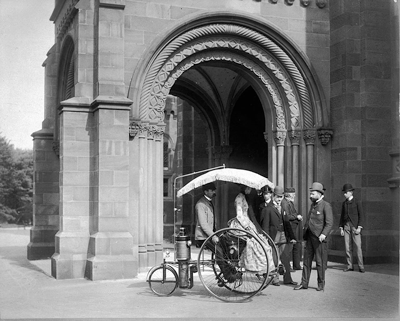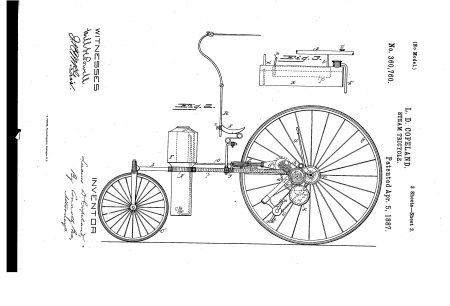
By the time he visited the Smithsonian, Copeland had already made a name for himself experimenting with steam propelled vehicles, from cars to bicycles to tricycles. His first foray into what is now referred to as an early motorcycle was in 1881, when he attached a steam boiler to a penny-farthing bicycle. Notably, the bicycle had a driving pulley, like the belt drive on a motorcycle.
A few years later, after Copeland had demonstrated his new invention on the West Coast, he set up shop in Camden, N.J. and decided to make some improvements. Those changes included a more powerful engine and a third wheel, allowing for a bench to seat multiple passengers.
Not quite a motorcycle—but not quite a tricycle—Lucius Copeland’s steam-powered three-wheeler could reach average speeds of 10 miles an hour on the road, with a range of 30 miles per tank of water. According to an 1887 description of the “rather novel steam tricycle,” published in the Washington D.C. Evening Star, water and steam exhaust pipes ran through the frame of the bike, powered by boiler-heated water, with its rear wheel driven by a leather belt. To demonstrate the power of his invention, Copeland traveled from his home in Camden to Atlantic City and back (a trip of approximately 120 miles), aboard his steam tricycle.
Copeland later took one of his machines, which he called the “Phaeton Moto-Cycle,” to the Smithsonian just a year after production on the machines began. It was typical during this time for scientists to demonstrate their latest innovations at the Smithsonian—in fact, Alexander Graham Bell demonstrated the telephone for Smithsonian Secretary Joseph Henry and his daughters at the Castle in 1877, a few days before Bell’s second patent on the invention was issued.
It was also a trend in Copeland’s time to experiment with the bicycle, an invention that had become wildly popular in the United States and Europe throughout the mid-to-late 1800s. The steam powered tricycle was one of many innovative new designs based off of the traditional penny-farthing bike. Designs for tricycles fitted with blades to paddle on the water, or with a “walking beam” footrest in place of pedals, or pulled by a team of dogs, were frequently featured in Popular Mechanics throughout the turn of the 20th century. Detachable bicycle motors, an evolution of Copeland’s invention, were even advertised in the magazine in the 1910s. Copeland’s “Moto-Cycle” was just one part of a larger cultural fascination with the bicycle and transportation innovation (one that continues with today's trendy electric-powered bikes).
Among the crowd to see Copeland’s machine in D.C. was John Elfreth Watkins, an engineer who became curator of the Smithsonian’s transportation collection (who began the institution’s cycle collection in 1889), along with Edwin H. Hawley, of the Department of Anthropology. The woman sitting on the cycle’s front seat was Frances Benjamin Johnston, an early female photojournalist, trained by George Eastman (of Eastman Kodak) and Thomas Smillie, the Smithsonian’s first photographer.
Copeland’s early motorcycle didn’t last long on the market, however. The business didn’t prove lucrative enough for Copeland and he retired in 1891. That didn’t stop his invention (or other steam-powered bicycles like it) from receiving considerable attention in newspaper pages across the country. When Copeland’s promoter, Sandford Northrop (pictured in the photo, to the left), returned to D.C. aboard his tricycle a year later, he made the Evening Star pages again for attracting “considerable attention on the streets” with a machine that was able to drive “at the rate of twelve miles per hour.”
A writer for the “Wheels and Wheelmen” column in Utah’s Salt Lake Herald, 1889, fondly recalled seeing a steam tricycle while in Philadelphia: “It certainly was a most beautiful vehicle and the steam apparatus the very acme of ingenuity.” (Though, the columnist was quick to note that the engine seemed too complicated for an everyday driver to handle).
And San Franciscan speed-racer John Broad was name-checked in his local newspaper in 1892 for “tearing through the gloaming at the rate of twenty miles an hour on his steam tricycle, and it was his whistling for the right of way that startled the neighbors.” When interviewed, Broad noted that he loved to “spin along the highways of his native city,” but found the actual pedaling of the bike “distasteful.” Rather, “what he wanted was exercise without the expenditure of physical force.” His solution? The steam tricycle.

Related Resources
An Ode to the Bicycle, The Bigger Picture Blog, Smithsonian Institution Archives
America on the Move: Smithsonian Bicycle Collection, National Musuem of American History
Object Project: Bicycles, National Musuem of American History
Produced by the Smithsonian Institution Archives. For copyright questions, please see the Terms of Use.


Leave a Comment